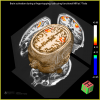Why Imaging?
Imaging and spectroscopy are key platform research technologies for studying structure and function at the molecular, cellular and whole organism levels.
Techniques such as NMR, EPR, MRI, PET, CT and optical imaging give us unique insight into the structure and function of biomolecules through to whole organisms.
CAI scientists are at the cutting edge of imaging research, working to develop new imaging agents and technologies, analyse molecular structure and function and study major diseases such as neurodegenerative diseases, cancer and cardiovascular disease. Our researchers play an active role in the development of novel imaging and spectroscopy technologies. For example, technology developed at UQ is incorporated into most clinical MRI scanners in use today.
CAI facilities are utilised for research programs in basic science through preclinical to biomedical imaging that form a translational imaging pipeline from the benchtop to the bedside.
 Magnetic Resonance Imaging (MRI) uses magnetic fields and radiowaves to characterise the blood flow and structure of living systems. CAI has state of the art facilities for human, animal and microimaging, including the first 7T scanner in the Southern Hemisphere for imaging of the human body with unprecedented detail.
Magnetic Resonance Imaging (MRI) uses magnetic fields and radiowaves to characterise the blood flow and structure of living systems. CAI has state of the art facilities for human, animal and microimaging, including the first 7T scanner in the Southern Hemisphere for imaging of the human body with unprecedented detail.
 Positron Emission Tomography (PET) involves the injection of tracer amounts of positron emitting radiopharmaceutical, and detection of areas of accumulation (eg in fast growing tumour cells). The world’s first commercial pre-clinical PET/MRI instrument at CAI provides simultaneous structural, functional and metabolic images for translational research in animal models of disease. This research is enabled by CAI’s state of the art cyclotron and radiochemistry facility.
Positron Emission Tomography (PET) involves the injection of tracer amounts of positron emitting radiopharmaceutical, and detection of areas of accumulation (eg in fast growing tumour cells). The world’s first commercial pre-clinical PET/MRI instrument at CAI provides simultaneous structural, functional and metabolic images for translational research in animal models of disease. This research is enabled by CAI’s state of the art cyclotron and radiochemistry facility.
 Computed Tomography (CT) uses X-rays and digital technology to create detailed 2D or 3D images of biological and non-biological samples and is particularly useful for imaging bone and blood vessels. CAI’s combined PET/CT scanner aids with the development of new diagnostic imaging agents for diseases such as cancer and dementia and for determining fracture porosity of core coal samples which is important for coal seam gas production.
Computed Tomography (CT) uses X-rays and digital technology to create detailed 2D or 3D images of biological and non-biological samples and is particularly useful for imaging bone and blood vessels. CAI’s combined PET/CT scanner aids with the development of new diagnostic imaging agents for diseases such as cancer and dementia and for determining fracture porosity of core coal samples which is important for coal seam gas production.
 Nuclear Magnetic Resonance (NMR) is a powerful, non-destructive tool for determining the structure of molecules from small molecules to large proteins and other biomolecules. NMR contributes to the understanding of the fundamental molecular basis of living systems and disease and facilitates the design and discovery of new drugs and therapeutic agents.
Nuclear Magnetic Resonance (NMR) is a powerful, non-destructive tool for determining the structure of molecules from small molecules to large proteins and other biomolecules. NMR contributes to the understanding of the fundamental molecular basis of living systems and disease and facilitates the design and discovery of new drugs and therapeutic agents.
 Electron Paragmagnetic Resonance (EPR) detects molecular species with unpaired electrons. CAI’s facilities, including the only pulsed EPR and EPR imaging systems in Australia, are invaluable for the study of small molecules, structural biology, materials science and analytical chemistry. EPR is also the basis for imaging free radicals, key agents of disease.
Electron Paragmagnetic Resonance (EPR) detects molecular species with unpaired electrons. CAI’s facilities, including the only pulsed EPR and EPR imaging systems in Australia, are invaluable for the study of small molecules, structural biology, materials science and analytical chemistry. EPR is also the basis for imaging free radicals, key agents of disease.
